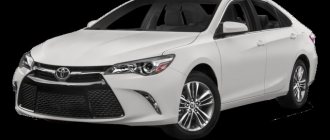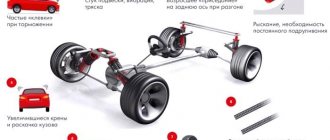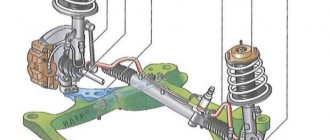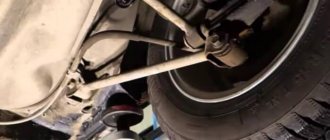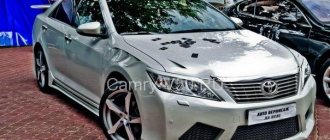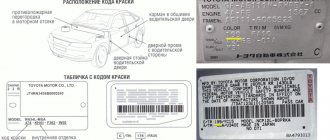Production of the Toyota Camry XV40 began in January 2006 and continued until 2011. In 2009, the car underwent minor design changes, but this did not affect the soft and comfortable suspension.
The shock absorbers supplied to the Toyota Camry 40 are divided into front and rear, in turn, the struts are divided according to the installation method into: left-hand and right-hand. A gas-oil type shock absorber is installed both front and rear. When selecting original shock absorbers for the front suspension, you should take into account the volume and power of the engine installed on the car, but if you choose an analogue, it will be easier to choose. Because the original spare part may only have a different number, but the dimensions are the same in both cases.
In different years of production, different manufacturers supplied shock absorbers to the Toyota assembly line, but these are the two main Japanese giants - KYB and Tokico. If you remove the original shock absorber from a Camry V40, it may be marked Toyota - KYB, or Toyota - Tokico.
When is it time to change shock absorbers?
The shock absorber is leaking (Link to photo source)
If the shock absorbers are not in order, the behavior of the Camry 50 on the road changes. Signs of failed racks:
- Excessive rocking of the car when accelerating and braking. A sharp press on the brake pedal should lead to a single rocking motion; with a sharp increase in speed, the same picture should be observed. If the rocking continues more than once, then this is a symptom of problems with the front shock absorbers of the Camry 50, as well as with the rear struts.
- Tilts when turning. When exiting a roll during a turn, the car body should not sway in the transverse direction. If such a picture is observed, the shock absorber requires replacement.
- Increased braking distance. Lack of proper vibration damping when braking a car prolongs the braking distance. Models with anti-lock braking systems especially suffer from this disease, since ABS reduces the pressure in the system. Thus, with faulty racks, the swinging only continues.
- The car pulls to the side when driving in a straight line. It feels like the driver is constantly steering despite the straight position of the steering wheel.
- The effect of motion sickness on passengers. If the rear shock absorbers are faulty, people in the cabin begin to experience discomfort during long trips.
These signs may not only indicate faulty racks. Similar symptoms appear when there is uneven tire pressure or problems in the suspension parts of the Toyota Camry 50. Therefore, it makes sense to carry out a comprehensive inspection of the car.
You can also determine the malfunction of parts visually by inspecting the components of the suspension structure. Obvious signs:
- Lubricant leaks on the rod and shock absorber body of a Toyota Camry. A worn oil seal is unable to retain oil inside the structure. Reducing its quantity leads to excessive wear.
- Worn silent block. Since a faulty Toyota Camry 50 shock absorber can work hard, the elastic rubber in the hinge becomes unusable, and the silent block fails. When checking shock absorbers, it makes sense to inspect the silent blocks.
- Traces of damage to the racks. A failed shock absorber may be bent, and rust may be visible on the rod. Fasteners must be checked carefully.
- Uneven tread wear on wheels. If uneven wear of the Camry 50 tires is noticed, then not only the shock absorbers, but also other suspension parts are subject to inspection.
(Link to photo source)
Checking the racks
Struts on cars with a simple suspension design can be checked by rocking. If the swing amplitude is strong, serviceable suspension elements will quickly stop the vibrations of the car body. A visual inspection will also bring results. If there are traces of corrosion on the rod or oil leaks, then the consumable needs to be replaced.
Toyota Camry 50 tires wear out more on the inside if the struts are faulty. Although this is not the only reason. You can check the car if you do a snake, braking and sharp acceleration at a speed of 50-60 km/h. Excessive swaying of the car body will indicate faulty Camry 50 shock absorbers.
Signs of failed springs
On the Toyota Camry 50, the springs may sag. Signs of this malfunction:
- subsidence of one of the sides of an unloaded car;
- metallic knocking when driving on uneven roads;
- low landing of the machine with light loading;
- increased vibration when driving on a flat road;
- loss of smoothness when driving through potholes;
- increased roll during normal (not sharp) braking.
If any of these symptoms are detected, it is necessary to organize diagnostics of the working units. A Camry 50 spring needs to be replaced if it is cracked completely or along one of the rings.
How to understand when it's time to change the springs
To determine when one or more Camry 40 suspension springs need replacing, consider the following factors:
- Spring sag in Camry 40 during visual comparison when the interior and trunk of the car are not loaded (no cargo or passengers). This involves inspecting either the two front or two rear springs, depending on where the problem is likely to occur. If the difference is significant, it means the spring has sagged or burst and must be replaced immediately. Sometimes the cause of subsidence is a failed glass, while the Camry 40 spring itself is in excellent condition.
- The appearance of peculiar metallic sounds when driving over uneven surfaces indicates a burst or cracked spring. Similar clangs and metal knocks are also observed when the ball or steering axle of a Camry fails.
- Reduced ground clearance even when the car is lightly loaded also indicates a problem with the springs. This is usually inherent in the rear part of the suspension, when the wheels rub against the fender liners at jumps, and the mud flaps drag on the ground. In such situations, it is worth contacting a car service center to prevent critical wear of your Camry tires.
- Vibration and shaking when driving, regardless of the condition of the road, which increases as the vehicle accelerates. This sign indicates that the spring has completely burst and requires replacement.
- Another sign of a faulty spring is a decrease in the smoothness of the car or a significant roll when braking.
Usually, when these symptoms are detected, they immediately contact a car repair shop for a full diagnosis of the suspension, since the signs of failure of some Camry suspension elements often coincide.
Articles for rear suspension
The original Camry 50 rear strut (right) goes under article number 4853080619. Analogue consumables:
Original right rear strut 4853080619
- TORR (DH1614R);
- TRW (JGM1243T);
- TRIALLI (AG19410);
- KAYABA (339359).
Original Camry 50 rear strut (left) – 4854080015. Analogs:
Original left rear strut
- TORR (DH1614L);
- TRW (JGM1243T);
- TRIALLI (AG19209).
Catalog numbers of the rear springs are original spare parts (4823133590), an analogue from KAYABA (RG5010).
Original rear spring 4823133590
Analogs of front shock absorbers Toyota Camry 40
It’s not difficult to find original shock absorbers on sale; their price is more or less adequate, as for original spare parts, but nevertheless, analogues are more often chosen, because they are cheaper and easier to choose.
| Manufacturer | Front left | Front right | price, rub. |
| Tokiko | B3327 | B3326 | 4500/4700 |
| KYB Excel-G series | 339024 | 339023 | 4600 |
| Sachs Super Touring series | 317116 | 317117 | 3600 |
| Monroe series Original | 72308ST | 72307ST | 4900/5300 |
| KYB series New-SR | NST5375L | NST5375R | 12500 |
Shock absorber KYB 339024
Shock absorber Tokico B3327
Replacing front shock absorbers Camry 50
Suspension parts must be replaced when a malfunction is detected. The procedure for replacing the front struts on a Toyota Camry 50 without devices for tightening the springs looks like this:
- Camry 50 is raised with a jack.
- The second lifting device places emphasis on the area of the ball joint and lifts the unit.
You need to lift it as far as possible so as not to remove the car from the main jack!
- The stabilizer link is unscrewed. You also need to remove the ABS wire and unscrew the brake hose.
- Use a 19mm socket to unscrew the Camry 50 strut rod. Use a 22mm wrench and a 22mm socket to unscrew the fasteners in the trunnion.
- The car is slowly lowered with a jack so that the stand can come out. The bolts are removed from the axle, and the old strut is finally removed. The clips for securing the ABS wire must be removed and cleaned. They are then installed on the new Camry 50 shock absorber.
clips
We put it on a new rack
- Rusted support cups can be cleaned and treated with a metal primer.
- New racks are pumped out and put in place in the reverse order.
Front shock absorbers for Toyota Camry 40
According to the owners of the Camry 40, the original front shock absorbers tend to stiffen and make unpleasant clicks in severe frosts, but as soon as the oil in the shock absorber reaches operating temperature, the shock absorber’s operation becomes quiet and soft. This does not mean that the original shock absorbers are bad or defective. The ability to harden in the cold is a feature of many shock absorbers. Just as the oil in the engine and gearbox thickens in the cold, the oil in the shock absorber also thickens.
| vendor code | Applicability | Rod diameter, mm | Case diameter, mm | Unfolded length, mm | Rod stroke, mm | Price | |
| Left | Right | ||||||
| Original numbers and sizes of front shock absorbers for Camry V40 | |||||||
| 4852080090 | 4851080309 | for cars with in-line 2.4 engine, 2AZFE | 22 | 51 | 543 | 176 | 8300/8000 |
| 4852080093 | 4851080312 | for cars with V6 3.5 engine, 2GRFE | 7500 | ||||
As you can see, the original numbers of the front shock absorbers are for cars with a 2.4 engine (2AZ-FE) and for cars with a 3.5 liter engine. (2GR-FE) - different, but in fact, the shock absorbers are the same.
Replacing rear struts Camry 50
(Link to photo source)


